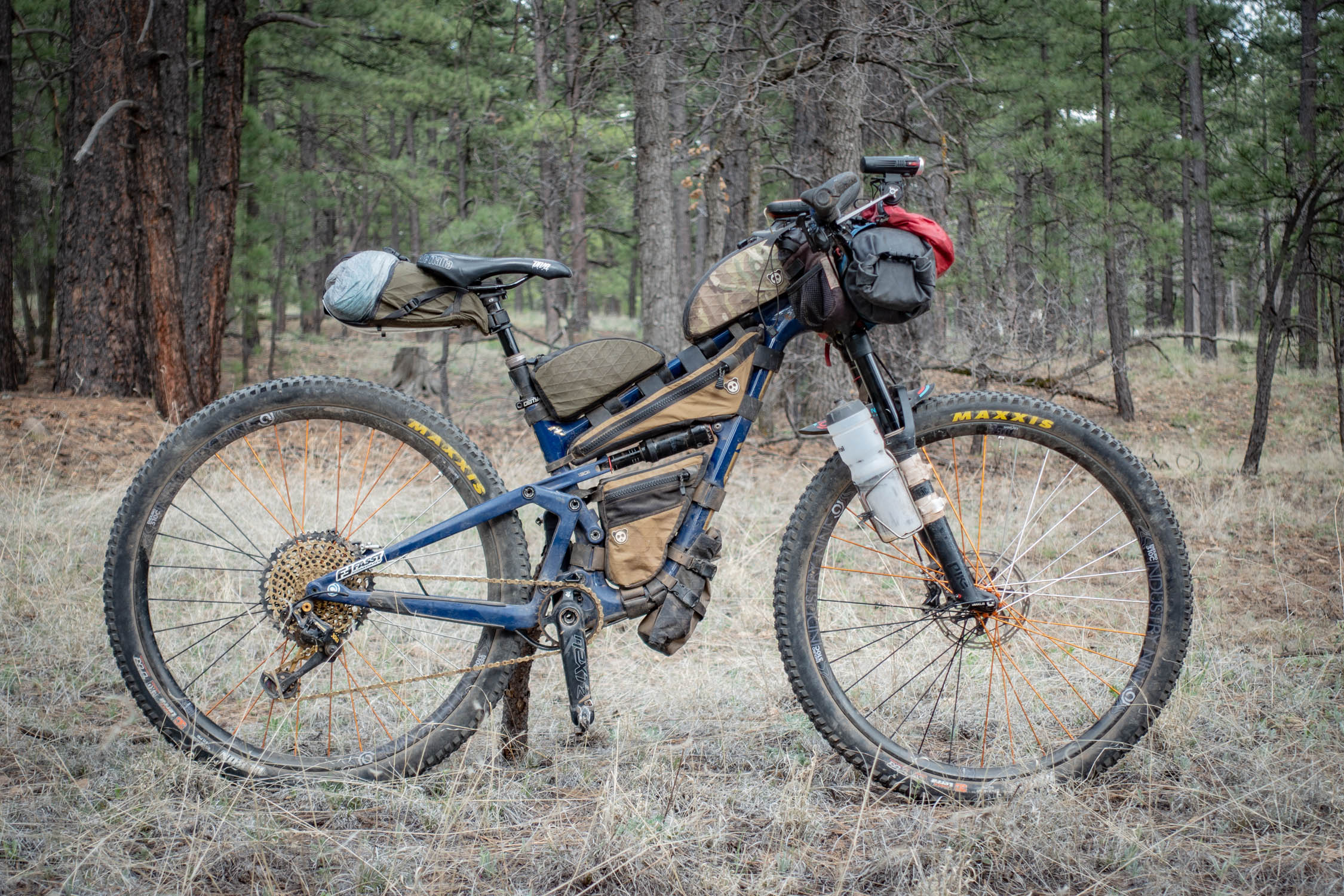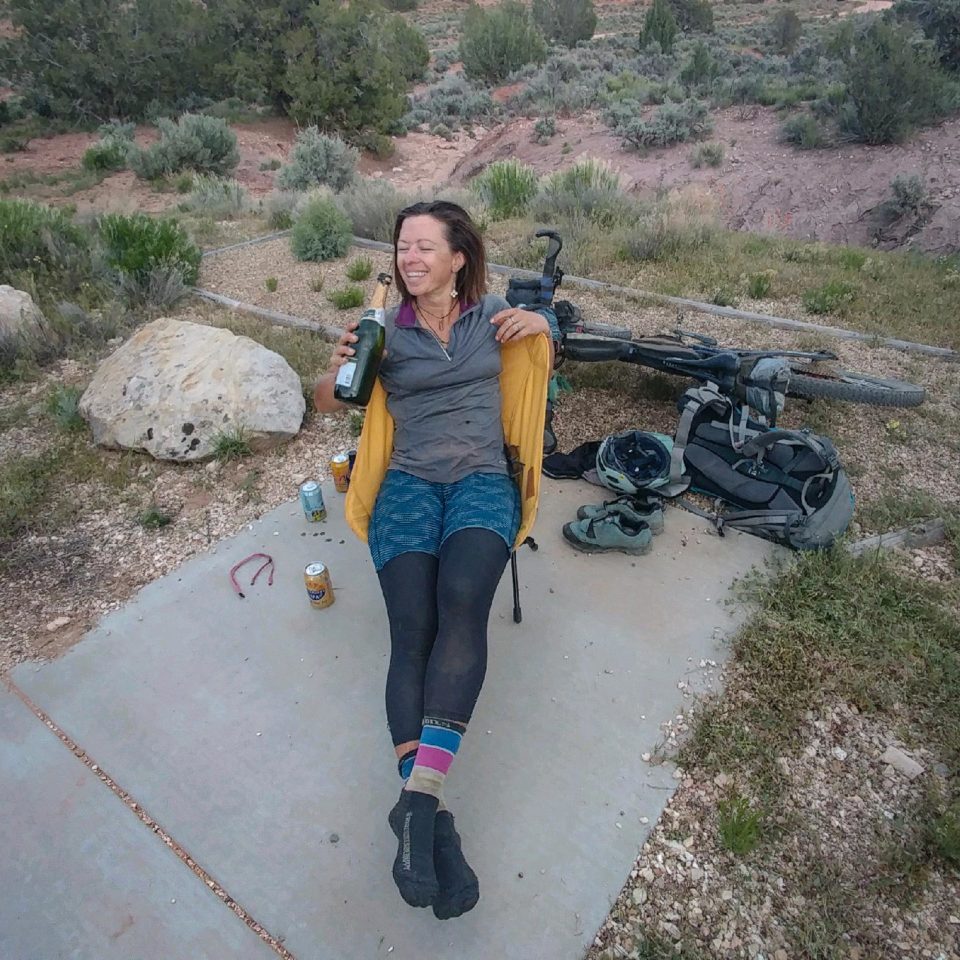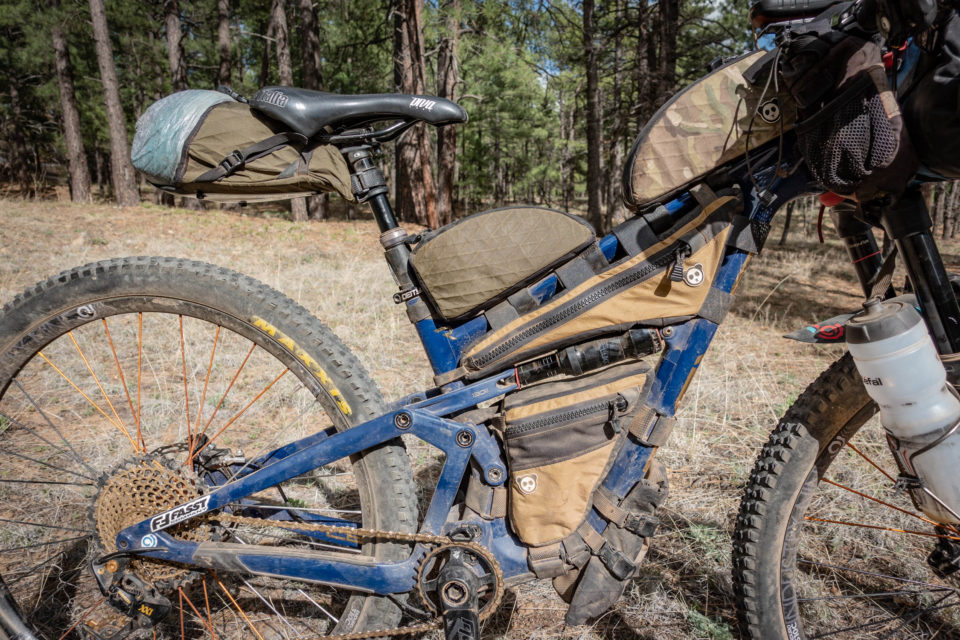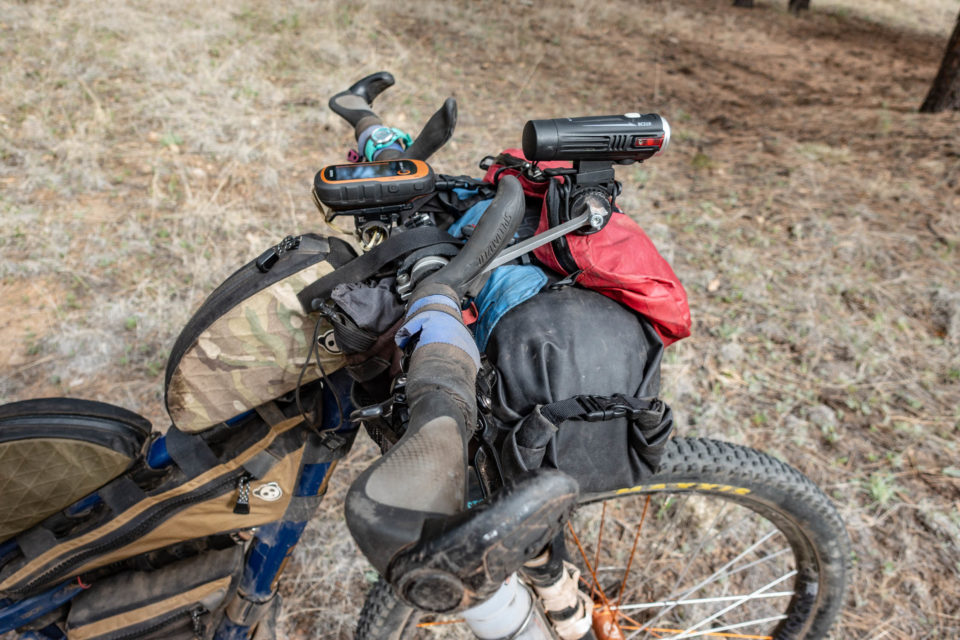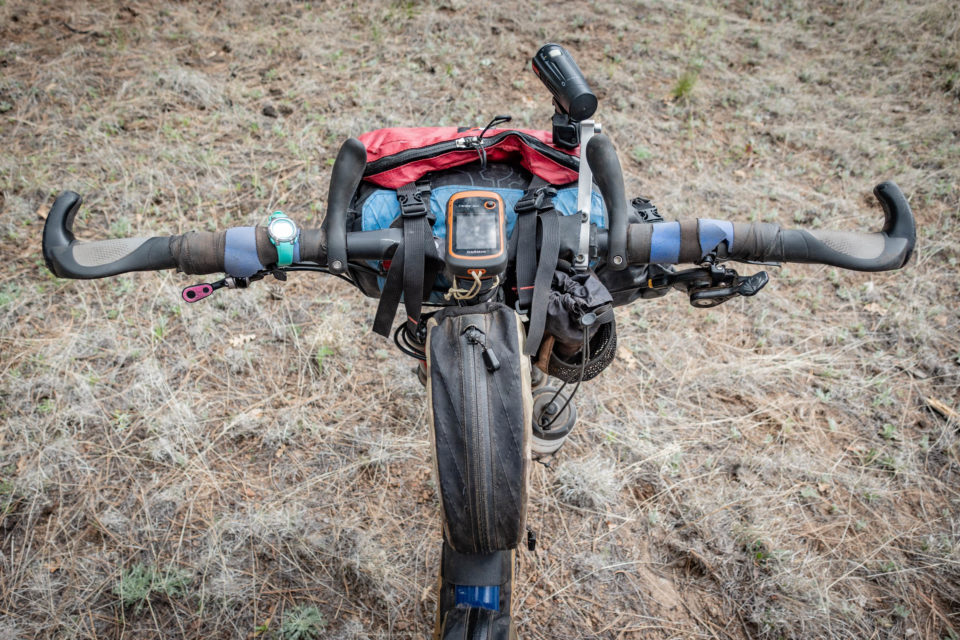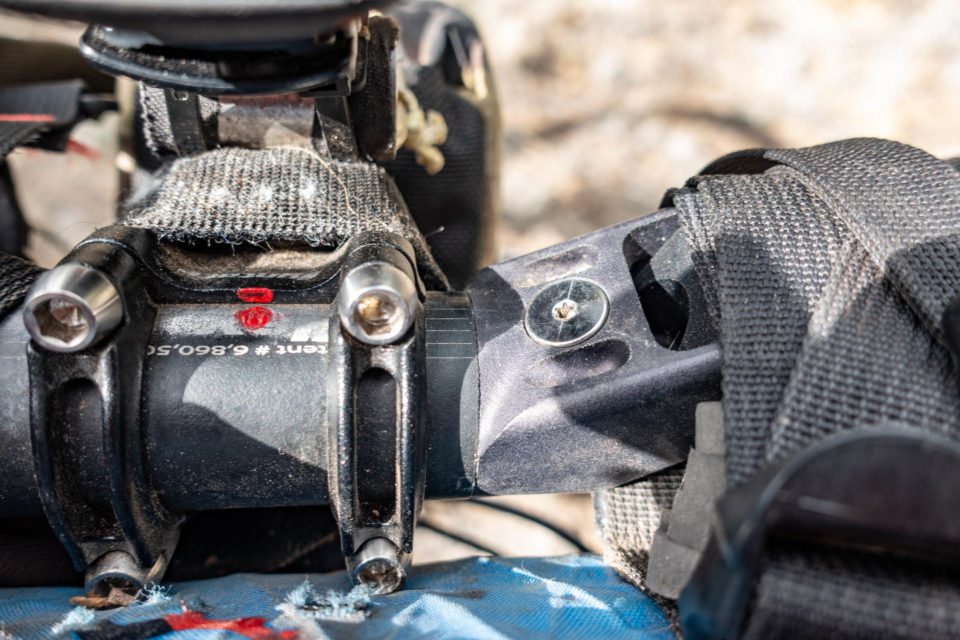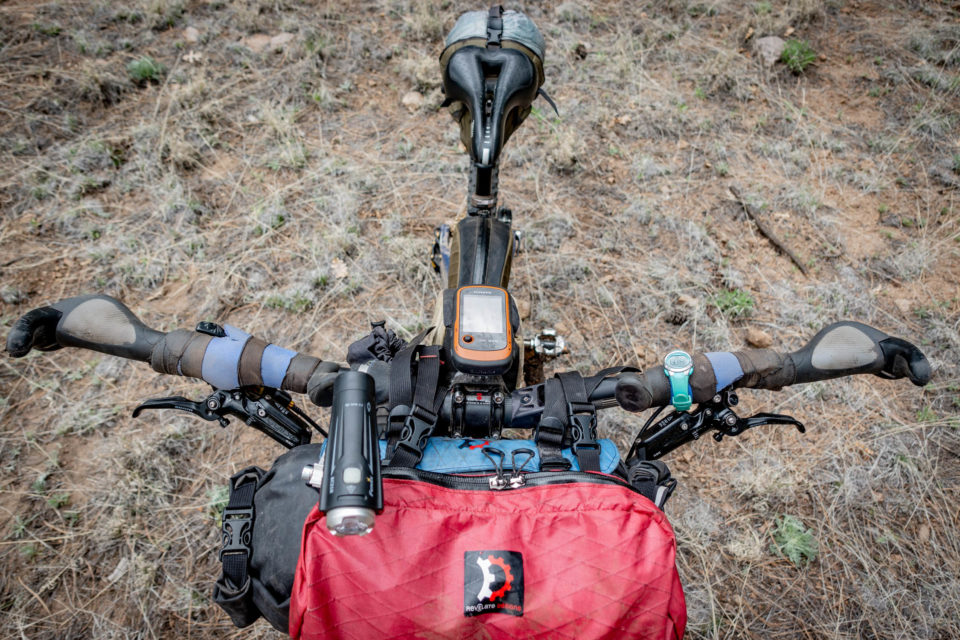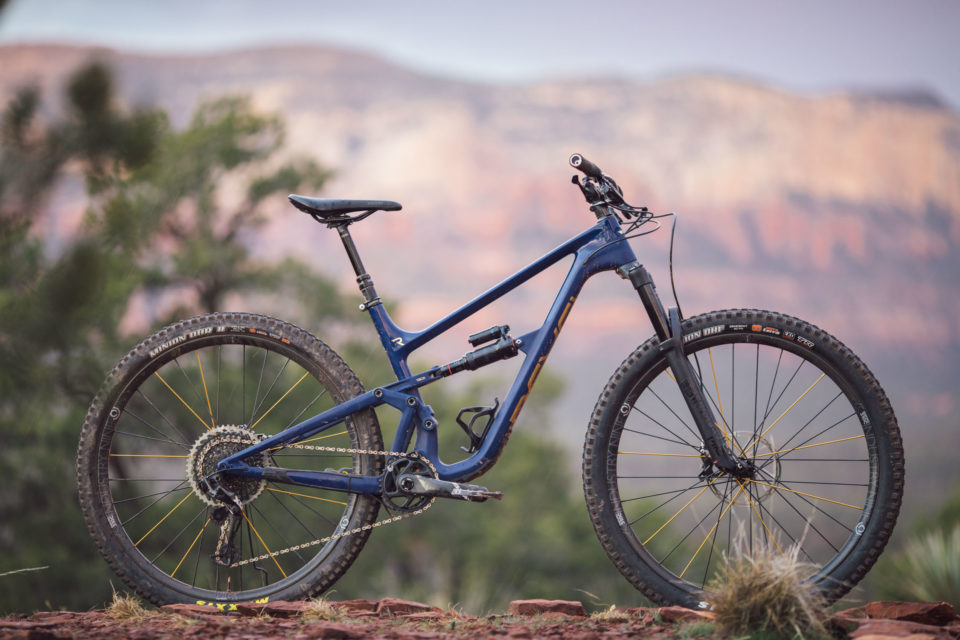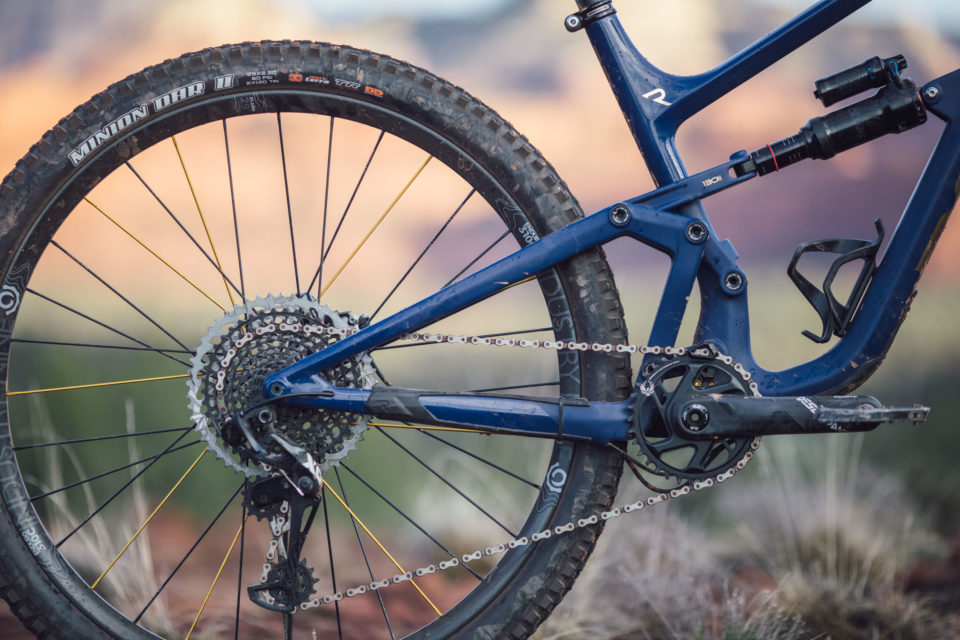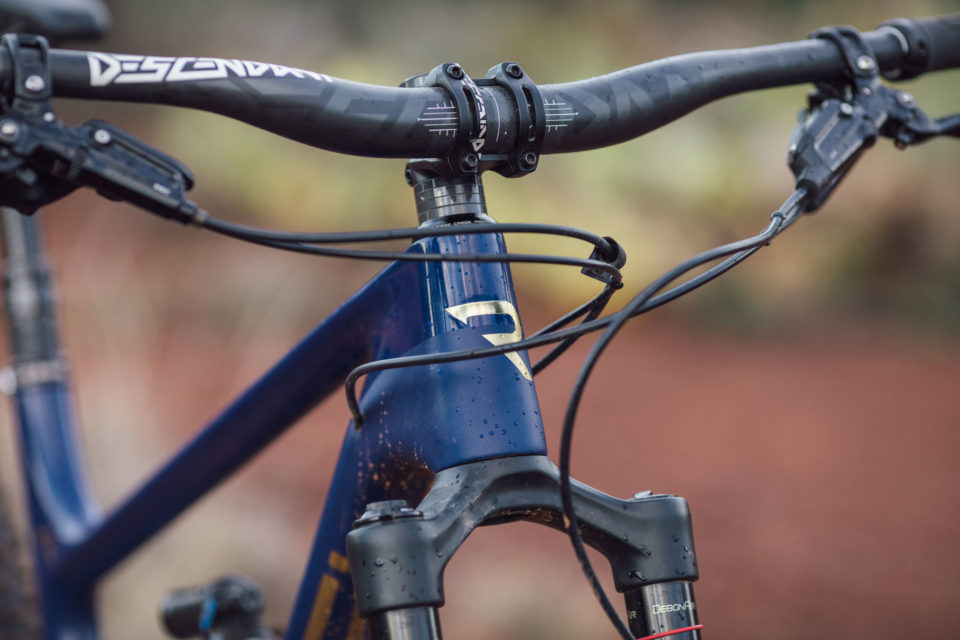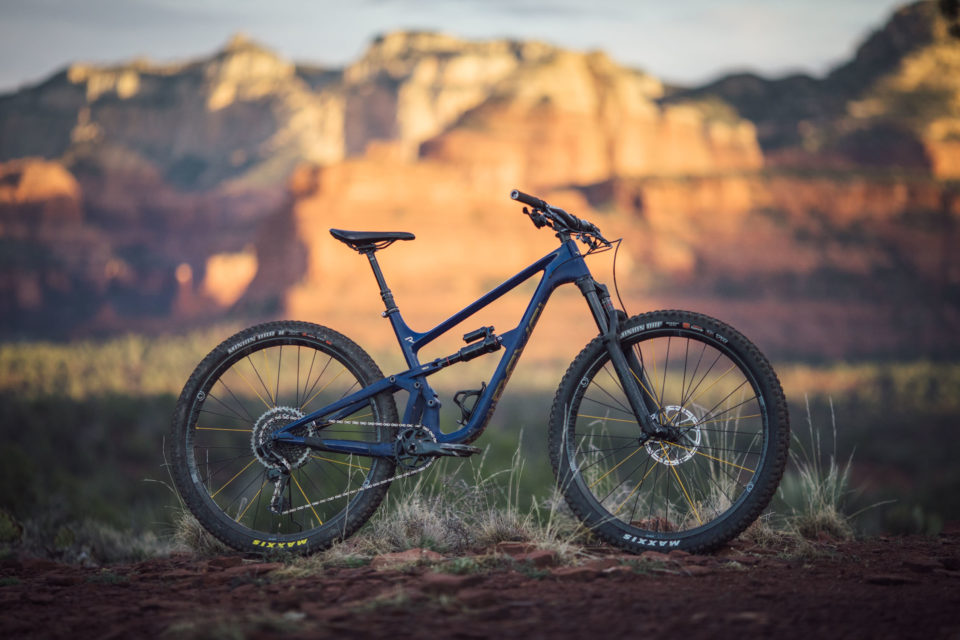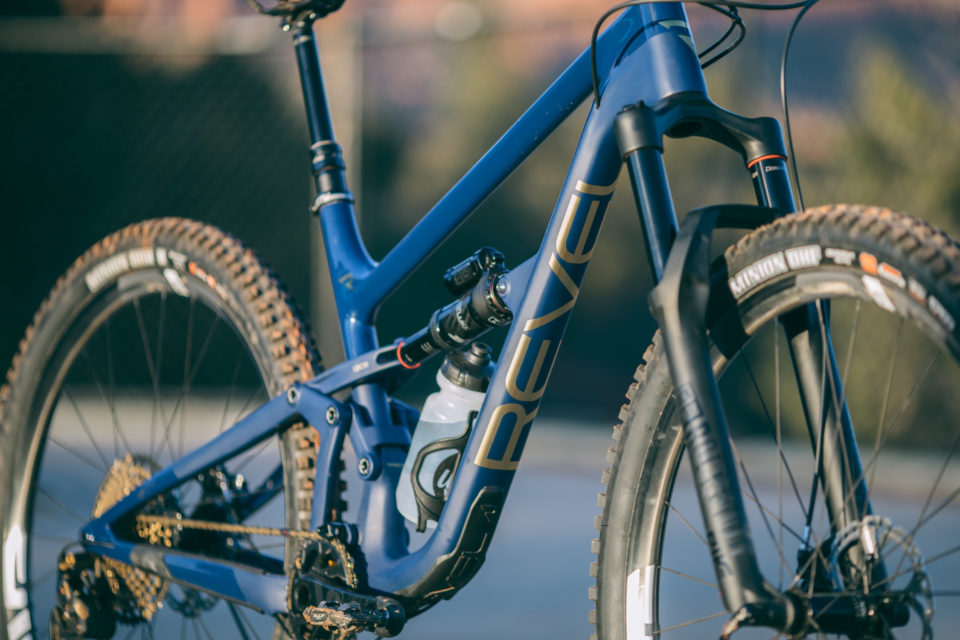Liz Sampey’s AZT750 Record, Kit List, and Revel Rascal
Share This
Liz Sampey just crushed the Arizona Trail 750 race and set a new women’s record by completing the journey from Mexico to Utah in just under 9.5 days. We asked Liz a few questions about her experience, her kit, and her Revel Rascal 29er she rode to the finish line. Find an inspiring Q&A, as well as her full gear list here…
In case you missed it, at 6:44 pm this past Saturday, April 27th, Elizabeth Sampey made it to the Utah state line and into the record books, becoming the fastest woman to ever complete the 750-mile Arizona Trail Race. Over the course of 9 days, 11 hours, and 44 minutes, Liz pedaled some of the finest and most rugged singletrack Arizona has to offer (and hiked with her bike and gear strapped to her back across the Grand Canyon) while making her way from the Mexico border to Utah. We caught up with Liz to ask her about her bike, gear, and experience out on the AZT. Here’s the full Q&A with photos, Liz’s full gear list, along with some additional thoughts about the Revel Rascal (the bike Liz rode).
First of all, congrats on your amazing finish. Can you tell us a little bit about yourself?
Thank you! I had so much fun out there. I’m originally from Minnesota, though I’ve lived in Colorado for most of my adult life. I’ve been full-time mobile for four years, either living in my van in the US/Canada or off my bike somewhere around the world. I’ve been racing bikes of all types on the road and mountain since 2007, bikepacking and doing expedition-style trips since 2015, and this was only my second ultra race. I raced the CTR last year and was leading the women’s field before an unlucky major mechanical ended my race 35 miles from the end. Thankfully, I had much better luck in the AZTR750!
Was this the first time you’ve ridden the entire Arizona Trail?
Yes, this was my first time riding the full thing! I’d only ridden a few very small parts before – the Canelos, some of the trails leading up to Mt. Lemmon, and the trails around Mt. Humphreys in Flagstaff.
What was your favorite part or parts of the trail?
My favorite part was the Highline Trail between Pine and the Mogollon Rim. I kept hearing about how awful it was, and I kept waiting for the awful parts to come, but they never did. Haha. I think people were just trying to scare me. I got on it right at sunset and it had been raining for hours and there was a beautiful rainbow stretched across the mountain.
I did encounter some death mud in the first few miles, but mostly it was a combination of some steep rugged climbs, some fast hike-a-bike, and so many ripping descents! I did most of it in the dark and I had such a blast. Ben Hanus was somewhere a few ridges ahead of me, and every so often I would hoot or laugh on a descent and I’d hear him echo me off in the distance. I camped near the bottom and hiked Mogollon Rim in the morning. It was a short but steep hike, and when I reached the top I was so excited to be up there and for me it symbolized the final third of my ride. The whole Highline/Mogollon experience was one of my favorite moments of the race.
I also really loved the Canelos, and I loved Oracle Ridge! I did that descent at sunrise and it was so steep and loose and fast, my brakes were locked up and I felt like I was skiing more than riding a bike. It reminded me of surfing volcanoes on my fat bike in Guatemala. I had an absolute blast (and also fried my rotors).
Any time I was night riding was awesome, too. I go so fast at night and have so much fun. Night riding is my most favorite thing in the entire world, and the hardest thing for me every night was making myself stop to sleep.

Did you have any crazy or scary moments?
Yeah, in the Grand Canyon. I was in there a really long time. I pushed the sleep deprivation pretty hard on those last couple of days, including the Canyon hike, and my load was really heavy with all the food and water I was carrying. I’m a really small person so it was a lot, and I’m really slow hiking downhill (there’s a reason I ride bikes and skis!). I’d been awake and pushing pretty hard for a full 24 hours and I definitely cracked at one point at around 4:00 a.m. in the canyon. I was having hallucinations and hearing full albums of music and conversations in the river, and saw a few weird things as well. But I was okay with all that. It was when I tripped on something and my load literally pulled me over backwards on a narrow trail that I got pretty freaked out. But I was able to get through it and keep moving. The hike uphill was much easier than the hike downhill!
Leading up to the race, what would you consider the most valuable training in your regimen to which you owe your success?
I spent a month backcountry skiing in southwestern Colorado, NOT on my bike, which consisted of hours upon hours of skinning steep uphills with a heavy pack and ski poles. This is exactly what the canyon hike uphill was like. When I was struggling in the canyon, I pictured myself hiking uphill through the deep snow with my heavy mountaineering pack on. My mantra was, “I’ve done this before, I can do it now.”
I also spent a lot of time in Arizona just getting used to the desert riding. I hadn’t ridden much in Arizona before this fall. I’ve been here since October, and when I first got here the riding was really foreign and intimidating to me. Everything is sharp or chunky or both. Even though I didn’t ride a whole lot of AZT, just getting used to this style of riding was really helpful. I spent a lot of the winter riding in the rugged Tucson Mountains, and by the time the race came around, desert chunk felt like an old friend. I’m a mountain girl, and I didn’t expect to fall in love with the desert, but I definitely have. I’m sad to leave it behind.
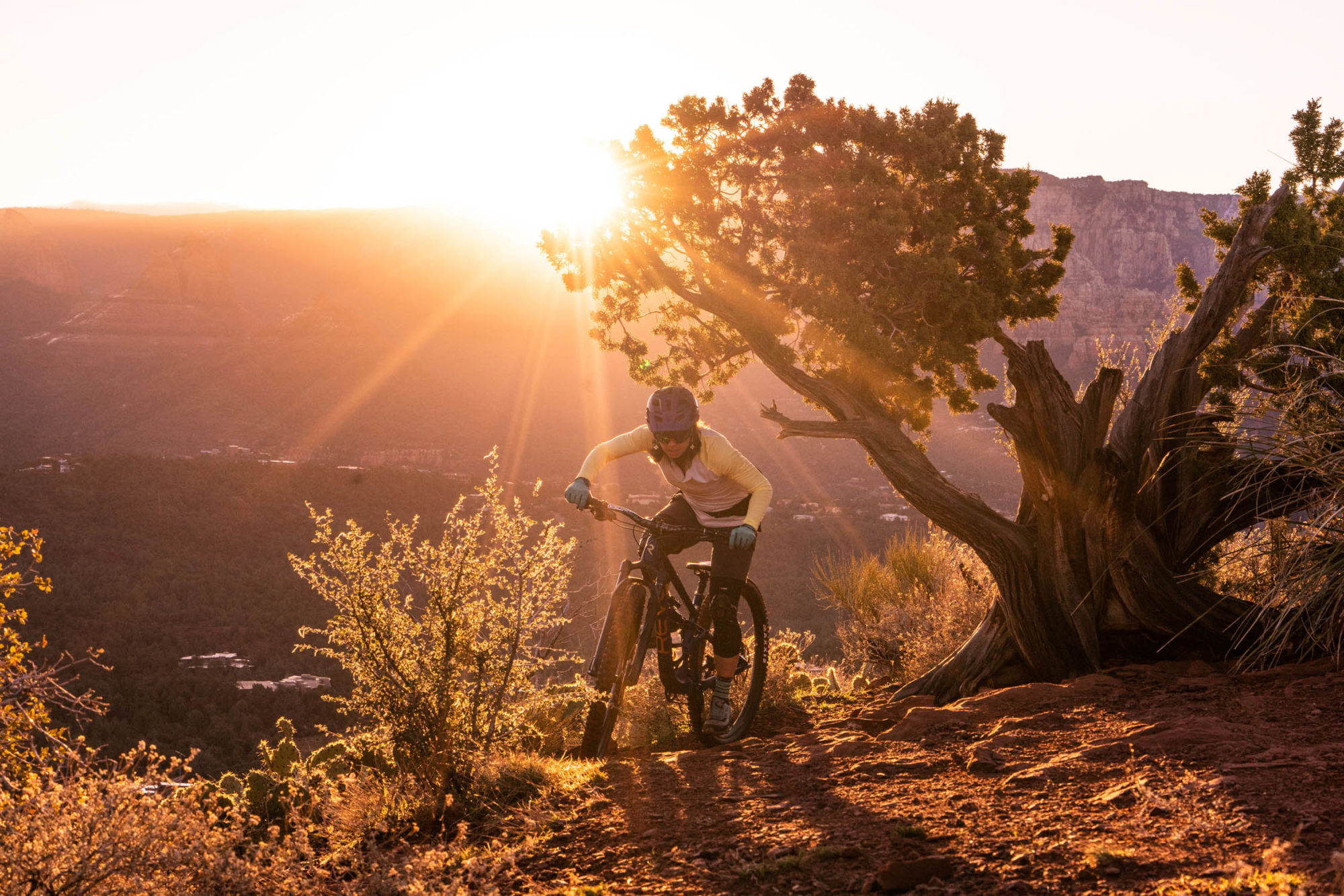
With such a strong finish time, did you have time to sleep?
I actually made sleep a big priority in this race. During the CTR last year, I really didn’t sleep much and my body broke down. I had a hunch that I would ride much faster and stronger on more sleep, and I was right. With this race being significantly longer, I wanted to make sure I kept myself healthy. You have to finish the ride to break the record! So, my top priority was keeping my body healthy enough to finish the ride. I slept four or five hours most nights, and one night I even got six hours. The last night, in the Grand Canyon, I went straight through. It was a 40-hour push from my camp about halfway between Flagstaff and the canyon to the very end. I knew I was going to do that, and I wanted to be sure I was ready. The bummer is that I always have a hard time falling asleep right when I get off the bike, so I always have to plan for lying there for an hour or more before I actually get any sleep. This is something I still have to figure out in my racing strategy.
Tell us a little bit about your nutrition plan and what you ate throughout the race.
I’m very meticulous and diligent about fueling. I’ll never be the one moving at a snail’s pace because I’ve run out of food. I plan my calories at resupply ahead of time based on my intended pacing and then I overestimate by a bit. If your engine has no gas, it won’t go. I always aim to eat between 250-300 calories per hour. I also know that after the first four or five days I turn into a furnace, so later in the race it needs to be closer to the 300 mark. I thrive on real food, like burritos, breakfast sandwiches, salami, tamales, slices of pizza, cheeseburgers, and french fries, so that’s mostly what I eat. I also had all types of cookies, Snickers, and a few boxes of sun-dried tomato Wheat Thins throughout the race. And every night I had an 8oz. Floyd’s of Leadville Recovery Protein drink with CBD. That was really key to recovering well every night, I think. And it helped me sleep better.
For hydration, I knew the first few days through the desert were going to be really hot – in the mid 90s – and I was intent on not letting that affect me. So I carried Gatorade powder and was really good about making sure I drank enough electrolytes in the first few days. I wasn’t really affected by the heat in the first 300 miles at all, so I definitely played that well.
Any tips, insight or recommendations you’d give a first time AZT rider?
Fueling is SO important! I talked with several other riders along the way who didn’t plan their calories, and many of them ended up having to ration or running out of food in long sections. In all my years of personal backcountry travel and also guiding others, I have a well-tested theory that anyone with a moderate amount of fitness can do big days in the mountains if they keep themselves well-fueled, and if they don’t blow themselves up by going too fast.
Pacing is also very important. I didn’t start really pushing myself until after the first 300 miles were over. I just rode in a way that felt good – which was actually pretty quick. I’m a really slow starter in the mornings and it takes me about an hour to warm my body up, so I have to tell myself not to push too hard until I’m warm. It’s easy for new racers to get caught up in the excitement of everyone around, you especially at the beginning, and push too hard and blow up in the Canelos. But if you ride your own ride, pacing how it feels good to you and remember to eat and drink, you should have a great ride.
Above all, don’t forget to have FUN! You’re on a week+ long bike ride through some of the most beautiful country in the world with some really amazing people! You get to see every sunset and sunrise from the seat of your bike. What could be better? If you’re not grinning like an idiot, you need to change something. Probably eat more, or just remember your sense of humor. I really think the main reason I rode so well is because I was having a blast the entire time. I just loved being out there. It’s such an incredible trail and the bike I was riding, the Revel Rascal 29er, was SO playful and fun. I was actually shredding trail instead of just suffering through it. Remember that all the hard or painful times will pass, and look for moments that make you smile to turn your attitude around.
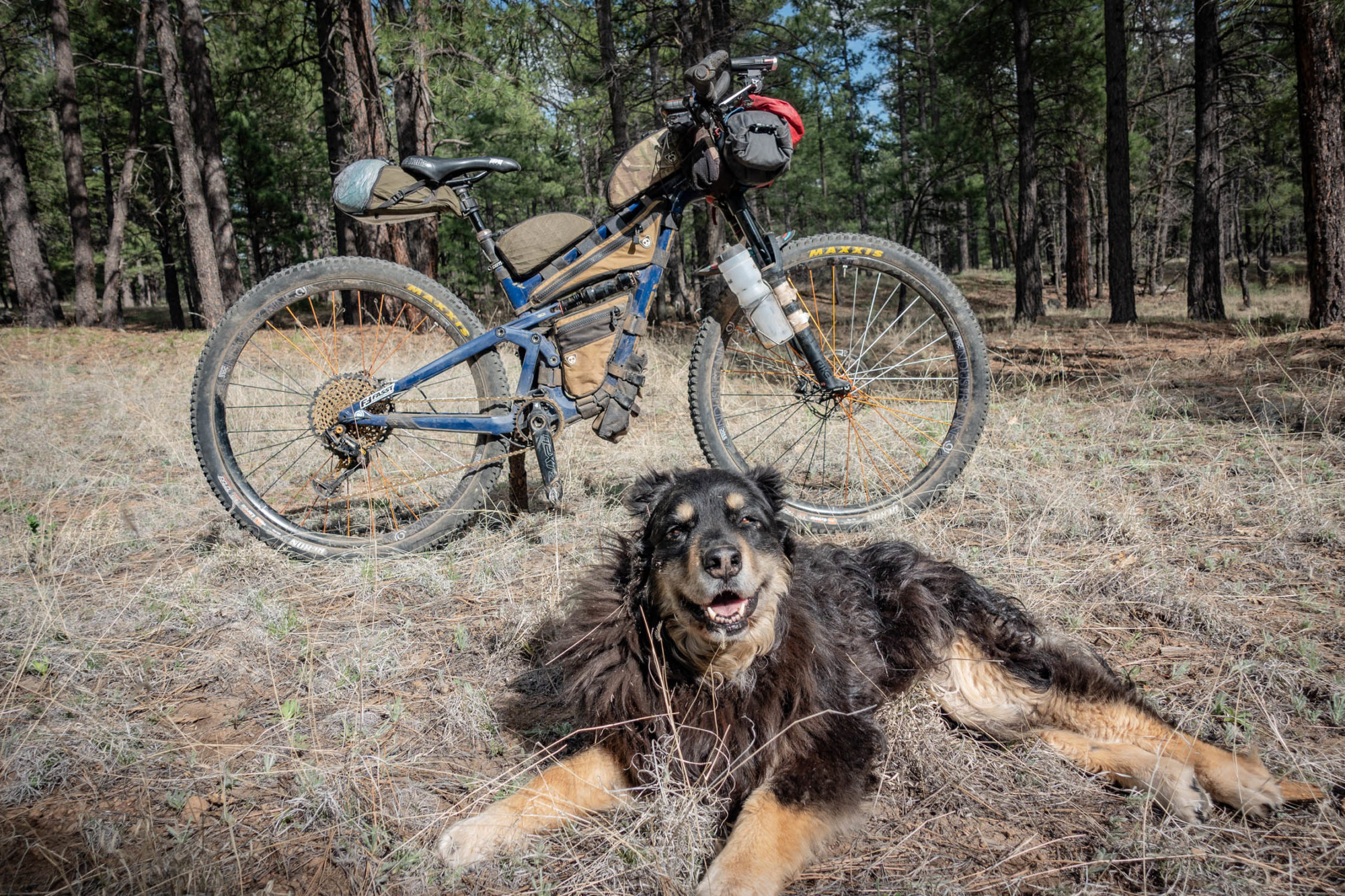
How’d you like the Rascal!? I spent a day on it in Sedona and really liked it.
Oh man. Don’t get me started, haha. This is hands down the most fun bike I have ever ridden. It’s the first time I’ve ever felt like I was actually riding well on a loaded bike, shredding the downhills and cruising the rocky climbs. The Canfield Balance Formula suspension design, tuned by the legend Jeremiah Starkey to be more efficient in pedaling than the original CBF, makes the drivetrain operate with maximum efficiency both uphill and down, during pedaling and braking. I actually HAD FUN on the Happy Jack trail, if that tells you anything. On miles and miles of Arizona chunk that crushes most bikes and beats up most riders, my Rascal was so efficient pedaling over that I was literally cruising along and laughing with delight.
Liz’s Full Gear Kit
Note that all this fit on a size small Revel Rascal…
Sleeping Gear
Western Mountaineering Summerlite 32deg bag, Montbell Sleeping Bag Cover (bivy), Klymit Inertia X Wave pad.
Clothes
Patagonia Ultralight Down Jacket, Ibex lightweight wool zip base layer, Pearl Izumi convertible wind jacket/vest, Icebreaker lightweight wool leggings, Icebreaker merino arm warmers, TLD lightweight knee warmers, ClubRide women’s Eden baggy short, one ultralight chamois (a reject from Kurt, don’t know the brand. I alternate between wearing a chamois and just a small baggy with no chamois), Icebreaker merino wool zip neck top, Icebreaker sports bra, one pair Handup gloves. One pair mid-weight wool gloves, one pair ultralight wind glove liners. Small polar fleece hat and Buff for sleeping, one buff used as a pee rag. Favorite dangly daisy earrings.
Electronics
On helmet the Fenix PD35 flashlight, on bars the Fenix BC21R mounted on a custom handlebar mount made by Clint Spiegel of I9. Lots of batteries. Sony RX100V camera with one extra battery. Garmin eTrex 20. Garmin InReach tracker. LG V20 smartphone used as a backup GPS with GaiaGPS and used to play music, with one extra battery. Am$9 Walmart watch to keep time and make sure I’m on my splits. Kitchen timer to wake me up from short sleeps. Goal Zero Flip20 battery bank (this was VERY minimalist – I chose to not make any phone calls, or really turn my phone on more than a handful of times during the entire race. People who want to use their phone more will need a bigger battery bank).
Shoes
Pearl Izumi men’s x-alp elevate shoe (women’s shoes are too narrow for me, so I wear men’s). I had to cut X’s in both little toe sides to relieve pressure after a few days – I have very wide feet!
Pack
Osprey Raven 14 for the ride portion. For the Canyon hike I shipped myself the Deuter Guide 35+ and a pair of ultralight carbon trekking poles to the post office in Flagstaff. I also shipped some approach shoes but the Pearl Izumis ended up being more comfortable, so I took the cleats out and just hiked in those.
Bikepacking bags
Nearly everything by Rogue Panda Designs, including a prototype seatpost bag which is probably the best bikepacking product I’ve ever used. My handlebar harness/roll system was from Revelate Designs.
Small first aid kit
Firestarter, tinder and waterproof matches, suture kit, steri strips, a bit of gauze, bandaids, athletic tape, gorilla tape, ibuprofen (which I took NONE of until the Canyon), Floyd’s CBD softgels, small vial of Floyd’s topical CBD.
Butt hygiene kit
Wet wipes, antibiotic ointment, benzoyl peroxide and antifungal cream all mixed together in a plastic bag. Butt hygiene every night is really important to prevent skin breakdown.
Cactus extraction kit
Tweezers, small pliers on tiny Leatherman, and 80s afro pick comb for cholla balls.
Bike Repair kit
Multitool, small Leatherman, derailleur hanger, derailleur cable, one small bottle of sealant, curved surgical needle and upholstery thread, tire boot, one C02 with micro head, one ultralight tube, patch kit, heaps of tire plugs, small Lezyne pump, extra cleat, two pairs of extra brake pads, two spokes, assortment of appropriate screws, 1 tire lever, master link, bit of chain, tiny bottle of chain lube, 2″ by 2″ rag, sawed off bristly end of Park Tool cassette cleaner. I think that’s it!
It looks like you made some upgrades to the bike, particularly the saddle and handlebar set. Can you tell us a little bit about those components and why you chose them?
The handlebars are the Flexx MTB handlebars from Fasst Company. They have a flexible elastomer in the articulation which provides a little bit of suspension in the handle bar. I switched to these right before the AZTR750 and they were instrumental in keeping my upper body healthy, reducing trauma and fatigue on my hands and wrists. I have broken my right wrist four times and have chronic tendonitis, so keeping that side from getting too fatigued is really important for my ability to hold on to my bars and handle the bike properly. Especially on Arizona’s rough trails, they made such a huge difference. I didn’t have any hand, wrist, arm or neck pain in the race. And this is really unusual for me. I highly recommend these to anyone who wants to avoid upper body overuse injuries, or anyone who is already dealing with problems there.
My saddle is the Selle Italia Diva. I tried probably 12 saddles before I finally found one that I could comfortably ride on all day. I’ve used this since my road racing days, probably since 2008. I’ve had a whole slew of them! The only thing I don’t like is that I usually have to replace it mid-way through the year, and they’re not cheap. But I guess I put a whole lot of miles on them!
How have you spent the last couple days after finishing the race?
Doing a whole lot of nothing! I’m recovering at a buddy’s house in Flagstaff, and I’ve taken a few epsom salt baths, eaten him out of house and home, and slept a lot. Cuddled with my dog.It’s been three days since I’ve finished, and I actually feel great. The leg soreness, swelling, and foot blisters from the Grand Canyon have subsided, and I actually want to ride my bike again already! I’m going to be smart, though. I’m going packrafting this weekend instead.
Any upcoming trips or events you have on your schedule for the summer?
I actually didn’t plan anything past the AZTR, because I didn’t know how my body would feel. I was so beat up after the CTR that I could barely walk for two months. Now that I feel great, though, I’m psyched to do a couple of expedition-style trips (which is what I do mostly). I’ll spend the summer living in my van up in British Columbia and the Pacific NW, mountain biking and packrafting, and if I’m feeling frisky I just might drop down into Colorado for a little race at the end of July. I’ve got some unfinished business there. I’m also really excited to put more time into my coaching and adventure retreat business. I love sharing my passion for adventure with others because it’s changed my life so much, and I’m always looking for new ways to open doors for other people to experience their own version of what I do.

Anyone you’d like to thank?
Revel Bikes, Industry Nine, Fasst Company, Rogue Panda Designs, Osprey Packs, and ClubRide for getting me dialed in for the race. Kurt Refsnider for sitting down with me and talking me through the entire AZT course when I decided to commit to the race last fall, and for teaching me most everything I know about ultra racing before the CTR last year (my first ultra). Kurt knows more about the Arizona Trail than anyone else out there, and his intimate knowledge of the course was so valuable. Chris Reichel for introducing me to Revel and what their crew was dreaming up. As soon as I heard about the bikes and the crack team of industry legends behind them, I knew the Rascal was the exact bike I wanted to race on. All the other AZT racers out there sharing that experience with me. It was really special to share some miles with some truly exceptional humans. I’m so grateful for this community.
Thanks for taking the time to answer those questions, Liz! Make sure to follow Liz over on Instagram @elizasampey, on Facebook, and check out her website vitalmotionlife.com.
Additionally—I’ve been looking for a place to fit in these thoughts—scroll down for more photos and my first impressions on the Revel Rascal.
Is this a bikepacking bike?
Someone commented with this question regarding the Rascal when I posted it on social a few weeks ago. So if Liz’s AZT750 win doesn’t answer that question for you, I’ll add my stance on the matter. In short, the best bikepacking bike is whatever bike works well for you. After a lot of rave reviews, this bike clearly works for a lot of people, as it did for me during my relatively short time with it.
Honestly, that question was likely based on the Rascal’s lack of frame bag space. A fair point. However, Liz’s custom Rogue Panda bags demonstrate that there is a solution. After riding this bike for a long day ride in Sedona, I think it has a lot of characteristics that many bikepackers will really like. Here are more photos I grabbed that day and some additional thoughts…

I feel like I’m belaboring my opinion since I mentioned this in a post the other day, but I think short travel 29ers are the magic bullet when it comes to long singletrack rides, bikepacking trips included. The combination of relatively lightweight suspension and large rolling diameter creates a nice blend of comfort, pedaling efficiency, and added rollover. All this leads to more confidence and speed on the trail, and less fatigue on rugged singletrack, as Liz also mentioned. These factors often make a 100/120mm travel 29er the choice rig for events like the Colorado Trail Race, or in this case, the Arizona Trail Race.
All that said, I wouldn’t necessarily classify the Rascal as a short travel 29er. Short in comparison to many trail bikes coming out these days, but I’ve generally reserved that moniker for sub-120mm bikes. Even so, with 130mm of really well-designed suspension, it pedals very much like a short travel 29er. Revel’s vision for the Rascal was to deliver a stable and ultra-versatile mountain bike for all applications. After pedaling it all over Sedona in one very long day, I’d back that claim. This bike is fast and fairly efficient. Whatever black magic fairy dust they sprinkled into the Canfield Balance Formula linkage design makes for an active suspension platform that pedals well, and seems to get better the more you push it. It’s also very nimble and confidence inspiring to the point that I executed a pretty major cartwheel fall riding a line that I shouldn’t have, way too fast.
The Rascal’s geometry is also right up my alley. With a 464mm reach in size large, the Rascal is long enough, but not overly so. It features a 66° head tube angle, which is tad bit slacker than many bikes in this class, but I quite liked it. In addition, it has a 75° seat tube angle and a 38mm bottom bracket drop. Both felt just about right to me. The Rascal has a nice in-the-bike feel that does what you want it to and simply wants to keep going.
Other standout specs include a 73mm threaded BB and clearance for 29 × 2.5″ tires. The Rascal is available in sizes small through XL in Navy or Black. Check it out over at RevelBikes.com.
FILED IN (CATEGORIES & TAGS)
Plan
Bikepacking Gear Lists
bikepacking-arizona bikepacking-ultra-racingPlease keep the conversation civil, constructive, and inclusive, or your comment will be removed.






